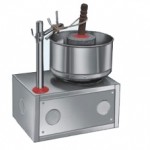Do you know how coffee is made? Well, the first step would be, it’s taken from the container and put in a bean hopper. This isn’t bad at all, isn’t it? Not for long, the grinder will be turned on and you’ll hear the whizzing sound of the motor as it spins wildly, grinding the coffee beans into small particles. This is where your coffee for different purposes start.

The final result of the coffee usually depends on how it’s ground and the temperature after grinding. Yes, believe me, this truly affects the taste of coffee. Enough of that. For now, I’m going to discuss about how you can buy the perfect grinder for your home or upcoming business.
- How to Budget for a Grinder
Kitchen-Tilting-Wet-GrindersBeginners usually opt for the top of the line espresso machine and ignore the grinder, thinking it’s not as important as the former. This is one of the biggest mistakes a lot of people make. The truth is, if you want to make a flavorful coffee, you should be willing to invest in a grinder as well.
I recommended that you spend around the same amount you’re willing to spend for an espresso machine, and that should be up to $250. Likewise, if the amount of your espresso machine is greater than that, the grinder should be around 1/3 or more of the budgeted money. For instance, if your budget for an espresso machine is $700, spend around $350 for an espresso machine and $350 on the grinder.
- Stepped Grinders
Stepped Grinders”Step” refers to the way the grind thickness is modified. There are two types of grinders, namely: stepped grinders and stepless grinders. Stepped grinders have a preset thickness that is automatically set on the machine. It’s usually represented by a dial together with the labels, allowing you to set the grind coarseness of your beans. - Stepless Grinders
prestige-125-l-wet-grinder-pwg-03-large_c84175a37a6924f6a33020e9ddabd415The other type is the stepless grinder. This one has a knob and there aren’t any settings for it. The coarseness will depend on how you control the machine. The benefit of using this grinder is the fact that you wouldn’t be limited by the usual setting of the machine. You can grind your beans depending on your preference. - Level of Coarseness
Level of CoarsenessThere are a lot of types of coffee drinks, and that means there are different levels of coarseness as well. For instance, the ground used for French press coffee is usually coarser than what is often used for a shot of espresso. Most commercial grinders have a feature wherein you can modify the coarseness level. Though, for me, how it’s done is what makes the difference. - Coarseness Ranking
Coarseness RankingModerate: There’s no distinction in coarseness.
Good: This has a number of coarseness levels.
Better: This has several (usually 30-40) selections.
Best: A stepless grinder that will let you choose the perfect setting depending on your needs. - High Speed vs Low Speed
High Speed vs Low SpeedHigh Speed
High speed grinders also heat the coffee, but it offers the user the flexibility needed in deciding the ideal ground size. Also, they produce an accurate grind that they’re often referred to as “direct drive” grinders.
Low Speed
This is considered to be the “Cadillac” of grinders. Low speed grinders have no static charge, uses very low heat, noiseless, and you don’t have to worry about clogging up the grinding machine when using it.
- Burr or Blade?
wet-grinderThe burrs are the part that crushes the coffee beans into uniform size. It is categorized into two: the conical burrs and flat plate burrs.
On the other hand, although a blade grinder can also grind coffee, it doesn’t grind consistently unlike the burr grinder. The blade can be compared to a propeller and it chops the coffee beans into smaller pieces. Thus, the fineness will depend on how long you’ll operate the grinder.
Different types of blade:
Rotating flat blade
Conical burr blade
Flat burr blade
- Conical Burrs and Flat Plate Burrs
Flat Plate BurrsBoth of these can be used for commercial and home grinders. They’re capable of producing consistent grind that’s almost similar to any high-end espresso machines. The conical burrs are often used at a very low-speed gear reduction grinders.
Final Thoughts
The taste of your coffee depends on a number of factors, such as water temperature, ingredients, and the quality of grinder used. That’s why it’s important to familiarize yourself with the important things to consider when choosing a grinder, and I hope that this guide has given you the basics on how to pick the best grinder depending on your needs.